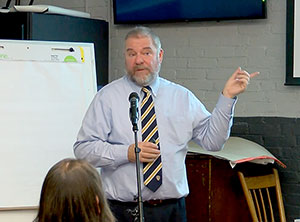
Weston & Sampson consultant George Naslas explained the complexities of the Conway Park contamination cleanup project to those attending last week’s information session.
By Jim Clark
A public information session concerning contamination at Conway Park was held on Wednesday, December 5, at the Public Safety Building.
Weston & Sampson, the licensed site professionals in charge of soil testing, and city staff were on hand to discuss the testing results and the next steps in the recovery process and to answer questions from those in attendance.
Representatives from the Environmental Protection Agency (EPA) and the Massachusetts Department of Environmental Protection (DEP), who have oversight over the testing and mitigation process, were also present to answer questions.
In preparation for the proposed renovation of Conway field in March of this year, soil testing conducted revealed contamination in the soil requiring its closure. Samples taken at various locations and depths identified contamination including lead and PCBs, some of which exceeded regulatory limits.
In accordance with state and federal guidelines and at the recommendation of the city’s consultant, additional testing would have to be conducted. Once testing results were determined, the city worked with the consultants as well as the MA Department of Environmental Protection and EPA to determine what remediation is required, as the field remained closed until that remediation is complete.
The site is now managed under the Massachusetts Contingency Plan and is also regulated under both the MCP and EPA’s Toxic Substances Control Act (TSCA).
At last week’s information session, Weston & Sampson provided a comprehensive overview including site history, the assessment process, regulatory overview, findings and draft data presentation, next steps, and then took questions from those in attendance.
Director of Parks and Open Spaces and Manager for the Conway Park Project Arn Franzen led off the session by introducing Weston & Sampson consultant George Naslas, who emphasized that the main purpose of the information session was to provide an update on the data collected since March.
Naslas then explained some of the background and history of the site and the discovery of the soil contaminants.
According to Naslas, the discovery of soil contaminants occurred while preparing to repair a retaining wall in the southeast corner of the park. The soil was tested at that time in order to determine what type of contaminants might be encountered during the renovation process.
Elevated level of lead and PCBs were subsequently discovered at relatively high concentrations across the park. At that point, it was determined that the park should be shut down and access restricted while testing was conducted to find out how severe the contamination was.
Naslas explained that the site had a history of industrial usage, which included a bleachery and dye works in the 1800’s, up to the early 1930’s. The site was first converted to a playing field sometime in the 1950’s and was renovated once in 1976 and again in 2001.
Naslas explained that the site is regulated by both Mass DEP and the EPA, making the cleanup process a highly regulated operation.
Naslas went through a typical cleanup timeline, explaining that the first year’s activities consist of preliminary response actions and initial assessments. Following tier classification, the cleanup process can often take as long as five years for the cleanup to be completed.
The presentation included detailed charts which graphically represent the various levels of contaminant concentrations throughout the park. Ultimately, it appeared to the consultancy experts that some areas of the site appeared to be more of a risk than others.
Naslas said that at this time the exact procedures involved in the cleanup have not yet been fully determined and that this is part of the ongoing effort that is underway currently.
During the question and answer portion of the session, members of the public were primarily concerned with knowing how much exposure to contaminants has been possible in past years, as well as how deep the cleanup process must go in order to assure public safety.
Naslas again reiterated that the exact details of these issues are yet to be precisely determined. He also emphasized the importance of getting the analysis and assessment phase of the operation right in the initial phase of the cleanup planning.
A video of the full session is available for viewing via the city’s website, https://www.somervillema.gov/departments/conway-field-and-playground-contamination
















Reader Comments